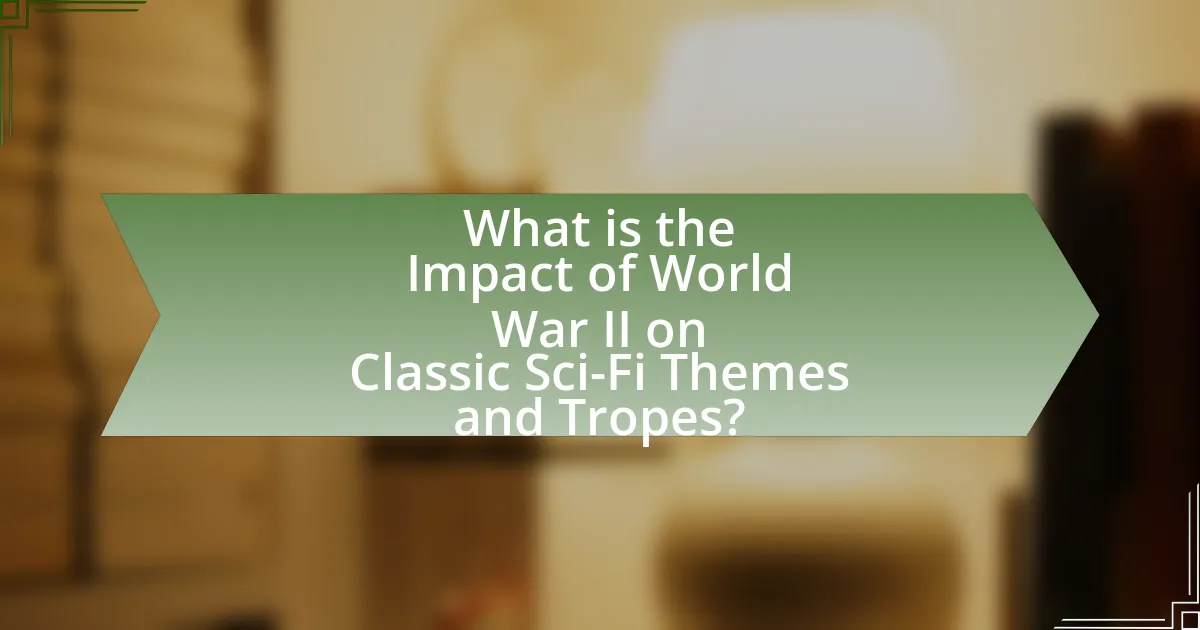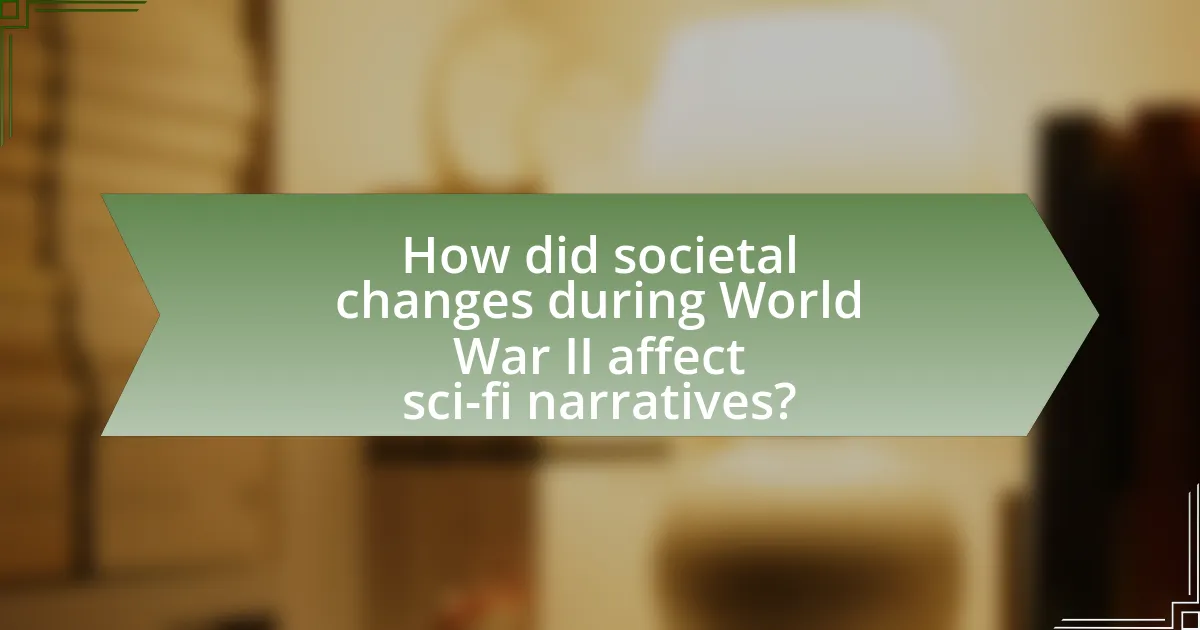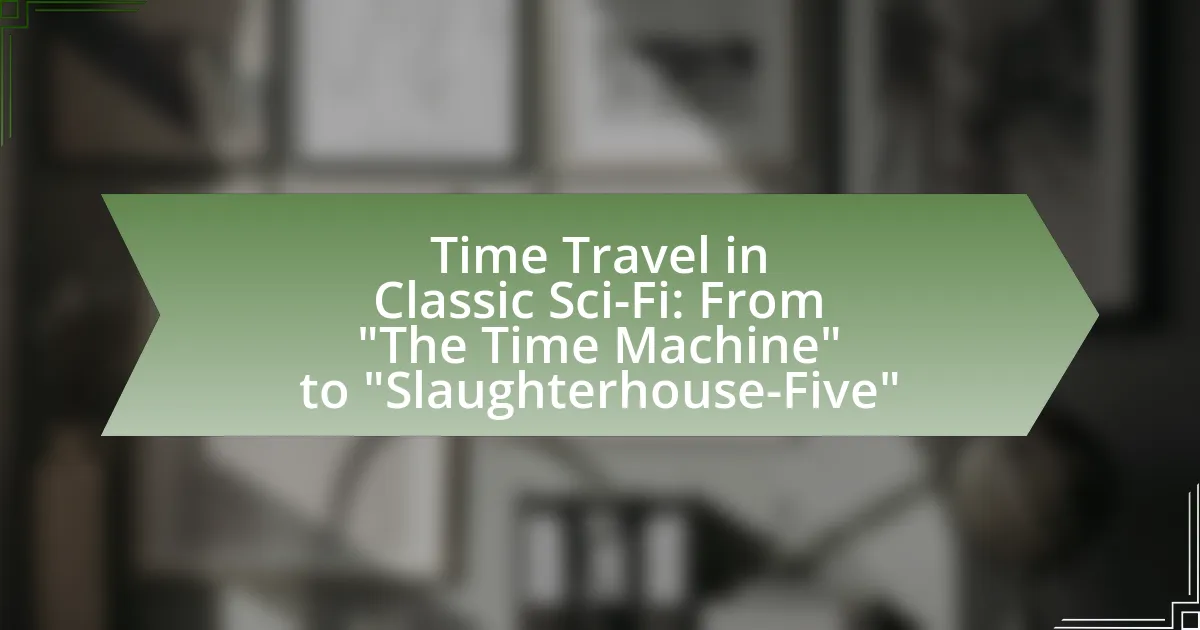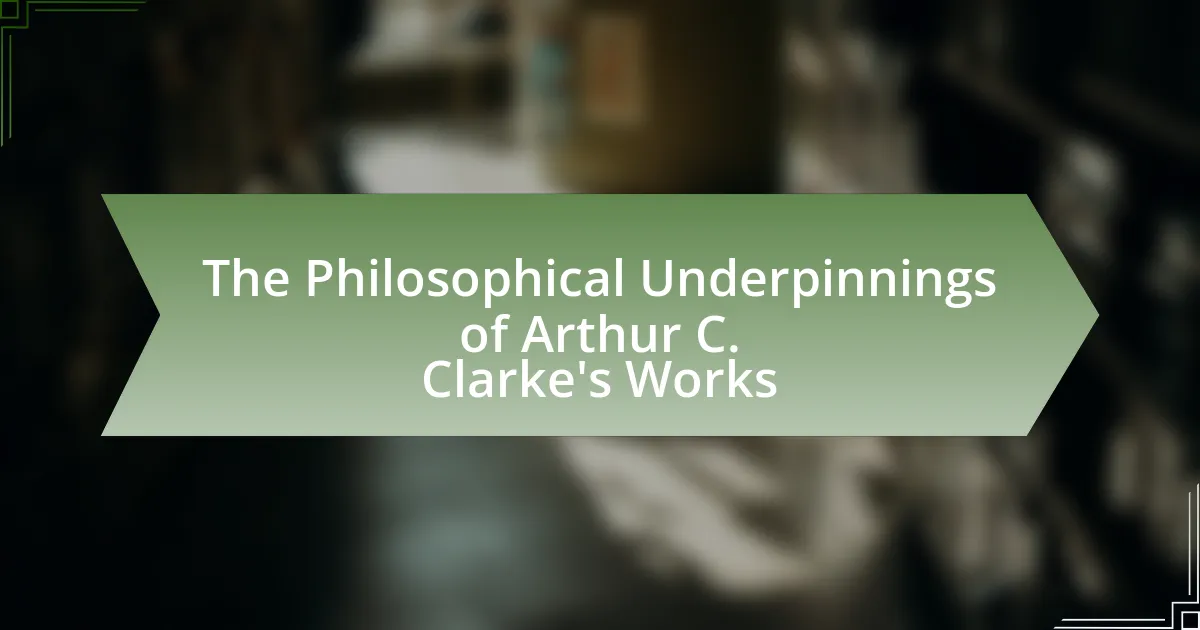The article examines the significant impact of World War II on classic science fiction themes and tropes, highlighting how the war introduced concepts of dystopia, advanced technology, and moral dilemmas. It discusses how authors like George Orwell and Isaac Asimov reflected societal anxieties about totalitarianism and the consequences of scientific advancements in their works. The article also explores the evolution of sci-fi narratives, including the portrayal of technology, the representation of alien life, and the transformation of gender roles, all shaped by the war’s historical context. Additionally, it addresses the lasting effects of World War II on contemporary sci-fi, emphasizing the ongoing relevance of these themes in modern narratives.

What is the Impact of World War II on Classic Sci-Fi Themes and Tropes?
World War II significantly influenced classic sci-fi themes and tropes by introducing concepts of dystopia, advanced technology, and the exploration of human morality in the face of existential threats. The war’s unprecedented destruction and the rise of totalitarian regimes prompted authors to explore the consequences of unchecked power and the fragility of civilization, as seen in works like George Orwell’s “1984” and Aldous Huxley’s “Brave New World.” Additionally, the technological advancements during the war, such as radar and atomic energy, inspired narratives centered around futuristic technology and its potential for both progress and destruction, exemplified in Isaac Asimov’s robot stories and Arthur C. Clarke’s works. These themes reflect the anxieties and hopes of a post-war society grappling with the implications of its own advancements and the moral dilemmas they entail.
How did World War II influence the development of science fiction literature?
World War II significantly influenced the development of science fiction literature by introducing themes of dystopia, technology, and the human condition under extreme circumstances. The war’s unprecedented destruction and the rise of advanced technologies, such as nuclear weapons, prompted authors to explore the consequences of scientific advancements and moral dilemmas. For instance, works like “Fahrenheit 451” by Ray Bradbury and “1984” by George Orwell reflect societal fears of totalitarianism and the loss of individuality, which were heightened during the war. Additionally, the post-war era saw an increase in speculative fiction that questioned humanity’s future, as seen in Isaac Asimov’s “Foundation” series, which examined the rise and fall of civilizations. These narratives were shaped by the war’s impact on global politics and human psychology, making science fiction a vehicle for exploring complex issues of morality, identity, and survival in a rapidly changing world.
What specific themes emerged in sci-fi literature during and after World War II?
During and after World War II, specific themes that emerged in sci-fi literature include dystopian futures, the exploration of technology’s impact on humanity, and the questioning of identity and morality. Dystopian futures became prominent as authors reflected on the devastation and totalitarian regimes experienced during the war, exemplified in works like George Orwell’s “1984.” The exploration of technology’s impact is evident in stories that grapple with the consequences of nuclear warfare and advanced technology, such as in Isaac Asimov’s “Foundation” series. Additionally, the questioning of identity and morality arose from the war’s ethical dilemmas, leading to narratives that examined what it means to be human, as seen in Philip K. Dick’s “Do Androids Dream of Electric Sheep?” These themes collectively illustrate how the war influenced the genre, prompting writers to address complex societal issues through speculative fiction.
How did the war shape the portrayal of technology in science fiction?
The war significantly influenced the portrayal of technology in science fiction by introducing themes of advanced weaponry, dystopian futures, and the ethical implications of technological advancements. During and after World War II, science fiction reflected society’s anxieties about the destructive potential of technology, as seen in works like George Orwell’s “1984” and Isaac Asimov’s “Foundation” series, which explored the consequences of totalitarian regimes and the role of technology in society. The development of nuclear weapons and the space race also inspired narratives that examined humanity’s relationship with technology, leading to a surge in stories that questioned the morality of scientific progress and its impact on civilization. This shift in portrayal can be traced back to the real-world experiences of war, where technology was both a tool for survival and a means of destruction, fundamentally altering public perception and literary representation of technological advancements in the genre.
What role did World War II play in the evolution of sci-fi tropes?
World War II significantly influenced the evolution of sci-fi tropes by introducing themes of dystopia, advanced technology, and the moral implications of scientific progress. The war’s unprecedented destruction and the development of nuclear weapons prompted writers to explore the darker aspects of humanity and the potential consequences of technological advancements. For instance, the atomic bomb’s impact led to narratives centered around apocalyptic scenarios and the fear of total annihilation, as seen in works like “On the Beach” by Nevil Shute. Additionally, the war’s experience with propaganda and totalitarian regimes inspired stories that critiqued authoritarianism, exemplified by George Orwell’s “1984.” These themes became foundational in shaping the genre, reflecting societal anxieties and the complex relationship between humanity and technology.
Which classic sci-fi tropes can be traced back to the experiences of World War II?
Classic sci-fi tropes that can be traced back to the experiences of World War II include the themes of dystopia, alien invasion, and the ethical implications of technology. Dystopian narratives often reflect the societal anxieties and totalitarian regimes that emerged during the war, as seen in works like George Orwell’s “1984,” which critiques oppressive governments. Alien invasion stories, such as H.G. Wells’ “The War of the Worlds,” can be interpreted as metaphors for the fear of foreign threats and the unknown, heightened by wartime experiences. Additionally, the ethical dilemmas surrounding advanced technology, particularly in the context of nuclear weapons, are explored in works like “The Day the Earth Stood Still,” highlighting the moral consequences of scientific advancements that were accelerated during the war. These tropes illustrate how the trauma and realities of World War II shaped the narrative landscape of classic science fiction.
How did the war impact the representation of alien life and other worlds in sci-fi?
The war significantly influenced the representation of alien life and other worlds in sci-fi by shifting narratives towards themes of conflict, survival, and the unknown. During and after World War II, science fiction began to reflect the anxieties and realities of human conflict, often portraying alien species as either hostile invaders or misunderstood beings, mirroring the fears of totalitarianism and the consequences of war. For instance, films like “The Day the Earth Stood Still” (1951) depicted aliens as cautionary figures, warning humanity against its destructive tendencies, while works such as “War of the Worlds” emphasized the fragility of civilization in the face of external threats. This transformation in representation can be traced back to the societal impact of the war, which fostered a sense of urgency and existential reflection in the genre.

How did societal changes during World War II affect sci-fi narratives?
Societal changes during World War II significantly influenced sci-fi narratives by introducing themes of dystopia, technology, and the human condition. The war prompted writers to explore the consequences of totalitarian regimes, as seen in works like George Orwell’s “1984,” which reflects fears of oppression and surveillance. Additionally, advancements in technology during the war, such as radar and atomic energy, inspired narratives that examined the duality of scientific progress and its potential for destruction, evident in stories like H.G. Wells’ “The World Set Free.” The collective trauma and existential questions raised by the war led to a deeper exploration of humanity’s moral dilemmas, shaping the genre’s evolution and its reflection of contemporary societal anxieties.
What societal fears and hopes were reflected in sci-fi stories post-World War II?
Post-World War II sci-fi stories reflected societal fears of nuclear annihilation and totalitarianism, alongside hopes for technological advancement and human resilience. The atomic bombings of Hiroshima and Nagasaki instilled a pervasive fear of nuclear war, leading to narratives like “On the Beach” by Nevil Shute, which depicted a post-apocalyptic world ravaged by radiation. Additionally, the rise of authoritarian regimes during the Cold War fueled anxieties about loss of freedom, as seen in George Orwell’s “1984,” which warned against oppressive governments. Conversely, these stories also expressed hopes for progress, as exemplified by Arthur C. Clarke’s “2001: A Space Odyssey,” which envisioned a future where humanity could transcend its limitations through technology and exploration. This duality of fear and hope in post-war sci-fi illustrates the complex societal landscape of the era, shaped by the trauma of war and the promise of a new technological age.
How did the concept of the “enemy” evolve in sci-fi narratives after the war?
The concept of the “enemy” in sci-fi narratives evolved significantly after World War II, shifting from clear-cut antagonists to more complex, multifaceted adversaries. This transformation reflected the changing societal perceptions of conflict, where the enemy was no longer just a foreign power but often represented internal struggles, moral dilemmas, and existential threats. For instance, in works like Philip K. Dick’s “The Man in the High Castle,” the enemy embodies the oppressive nature of totalitarian regimes, while in Arthur C. Clarke’s “Childhood’s End,” the enemy is an alien force that challenges humanity’s understanding of itself. This evolution illustrates a broader commentary on the nature of humanity and the ambiguity of good versus evil, influenced by the war’s aftermath and the onset of the Cold War, which introduced themes of paranoia and the fear of the unknown.
What impact did the war have on gender roles within sci-fi literature?
The war significantly transformed gender roles within sci-fi literature by challenging traditional depictions of women and men. During World War II, women entered the workforce in unprecedented numbers, leading to a shift in societal perceptions of gender capabilities. This shift was reflected in sci-fi literature, where female characters began to take on more active, complex roles, often depicted as strong leaders, scientists, or warriors, rather than merely supporting characters. For instance, works like “The Female Man” by Joanna Russ and “The Left Hand of Darkness” by Ursula K. Le Guin explored themes of gender fluidity and equality, directly influenced by the changing dynamics of the war era. This evolution in character representation marked a significant departure from earlier sci-fi narratives, which often reinforced stereotypical gender roles.
How did World War II influence the visual representation of sci-fi in film and media?
World War II significantly influenced the visual representation of sci-fi in film and media by introducing advanced technology and themes of dystopia and existentialism. The war accelerated technological advancements, such as radar and jet propulsion, which filmmakers incorporated into sci-fi narratives, exemplified by films like “Destination Moon” (1950) that showcased space travel as a realistic possibility. Additionally, the trauma and destruction of the war led to a focus on dystopian futures, as seen in “Metropolis” (1927) and later works, reflecting societal fears about totalitarianism and the misuse of technology. The post-war era also saw a rise in special effects, driven by the need to depict futuristic scenarios, which transformed the visual aesthetics of the genre, making it more dynamic and visually engaging.
What cinematic techniques were adopted in sci-fi films as a result of wartime innovations?
Cinematic techniques adopted in sci-fi films as a result of wartime innovations include the use of special effects, advanced sound design, and innovative camera techniques. During World War II, filmmakers developed new technologies such as miniatures for creating realistic explosions and aerial dogfights, which later influenced sci-fi films like “Star Wars.” Additionally, advancements in sound technology, including the use of synchronized sound and sound effects, enhanced the auditory experience in films like “The Day the Earth Stood Still.” Furthermore, wartime innovations in camera techniques, such as the use of deep focus and tracking shots, allowed for more dynamic storytelling, evident in classics like “2001: A Space Odyssey.” These techniques were directly influenced by the technological advancements and creative problem-solving necessitated by wartime filmmaking.
How did the aesthetics of sci-fi films change due to World War II?
The aesthetics of sci-fi films changed significantly due to World War II, shifting from optimistic visions of the future to darker, more dystopian themes. This transformation was influenced by the war’s technological advancements, such as radar and atomic energy, which introduced a sense of realism and urgency in storytelling. Films like “Metropolis” and “The Day the Earth Stood Still” reflected societal anxieties about technology and the potential for destruction, showcasing a more somber visual style characterized by stark contrasts and industrial imagery. The war also led to the incorporation of military elements and a focus on survival, as seen in works like “Destination Moon,” which emphasized the dangers of space exploration. These changes marked a departure from earlier, more utopian sci-fi aesthetics, aligning them with the complex realities of a post-war world.

What are the lasting effects of World War II on contemporary sci-fi themes?
The lasting effects of World War II on contemporary sci-fi themes include the exploration of dystopian futures, the ethical implications of technology, and the human condition in the face of existential threats. The war catalyzed a shift in narrative focus, as writers began to reflect on the horrors of totalitarian regimes and the potential for nuclear annihilation, leading to themes of oppression and survival in works like George Orwell’s “1984” and Ray Bradbury’s “Fahrenheit 451.” Additionally, the rapid advancements in technology during the war, such as radar and atomic energy, prompted sci-fi to delve into the moral dilemmas surrounding scientific progress, as seen in films like “Blade Runner” and series like “Black Mirror.” These themes resonate today, illustrating the ongoing relevance of World War II’s impact on societal fears and aspirations within the genre.
How do modern sci-fi works reflect the legacy of World War II?
Modern sci-fi works reflect the legacy of World War II through themes of dystopia, technological advancement, and the moral complexities of warfare. The aftermath of the war led to a heightened awareness of the potential consequences of scientific progress, as seen in narratives that explore the ethical implications of artificial intelligence and nuclear technology. For instance, films like “Blade Runner” and “The Matrix” illustrate the anxieties surrounding dehumanization and totalitarianism, echoing the societal fears that emerged from the war. Additionally, the portrayal of alien invasions often serves as an allegory for the existential threats faced during the conflict, emphasizing humanity’s struggle against oppressive forces. These elements demonstrate how modern sci-fi continues to grapple with the historical impact of World War II, shaping its narratives and themes.
What themes from World War II are still prevalent in today’s sci-fi narratives?
Themes from World War II that are still prevalent in today’s sci-fi narratives include the exploration of totalitarianism, the moral implications of advanced technology, and the consequences of war on humanity. Totalitarianism is often depicted through dystopian societies where oppressive regimes control citizens, reflecting the fears of authoritarianism that emerged during the war. The moral implications of advanced technology are illustrated in narratives that question the ethical use of scientific advancements, such as artificial intelligence and nuclear weapons, echoing the wartime developments in these fields. Additionally, the consequences of war on humanity are explored through themes of trauma, loss, and the struggle for survival, mirroring the profound psychological and societal impacts of World War II. These themes resonate in contemporary works like “The Handmaid’s Tale” and “Blade Runner,” which draw directly from the historical context of the war.
How has the portrayal of dystopian futures in sci-fi been influenced by World War II?
The portrayal of dystopian futures in sci-fi has been significantly influenced by World War II through the exploration of totalitarian regimes, the consequences of technological advancements, and the psychological impact of war. The war highlighted the dangers of authoritarianism, as seen in works like George Orwell’s “1984,” which reflects fears of oppressive governments that emerged during and after the conflict. Additionally, the development of nuclear weapons during WWII introduced themes of existential threat and societal collapse, evident in stories such as “A Canticle for Leibowitz” by Walter M. Miller Jr., which examines post-apocalyptic scenarios stemming from nuclear fallout. The psychological trauma experienced by soldiers and civilians during the war also contributed to a sense of disillusionment and paranoia, shaping narratives that question humanity’s future and moral compass, as illustrated in Philip K. Dick’s works. These elements collectively demonstrate how World War II has profoundly shaped the thematic landscape of dystopian science fiction.
What lessons can be learned from the impact of World War II on sci-fi themes and tropes?
World War II significantly influenced sci-fi themes and tropes, primarily by introducing concepts of dystopia, advanced technology, and the moral implications of warfare. The war’s devastation and the atomic bomb’s emergence prompted writers to explore the darker aspects of human nature and the potential consequences of scientific advancements. For instance, works like George Orwell’s “1984” and Aldous Huxley’s “Brave New World” reflect fears of totalitarianism and loss of individuality, stemming from wartime experiences. Additionally, the war accelerated technological innovation, leading to themes of space exploration and artificial intelligence, as seen in Isaac Asimov’s works. These narratives serve as cautionary tales about the ethical dilemmas posed by technology and the fragility of civilization, illustrating how the war reshaped the sci-fi genre to address contemporary anxieties and moral questions.
How can writers incorporate historical events like World War II into their sci-fi narratives?
Writers can incorporate historical events like World War II into their sci-fi narratives by using the war’s themes of conflict, technological advancement, and moral dilemmas as foundational elements in their stories. For instance, the development of radar and atomic energy during World War II can inspire futuristic technologies in a sci-fi setting, reflecting the duality of progress and destruction. Additionally, the ethical questions surrounding wartime decisions, such as the use of atomic bombs, can be explored through speculative scenarios involving advanced weaponry or artificial intelligence. This approach not only grounds the narrative in real historical context but also allows for a deeper exploration of human nature and societal consequences, as seen in works like Kurt Vonnegut’s “Slaughterhouse-Five,” which directly addresses the impact of war on individuals and society.
What best practices should be followed when exploring historical influences in sci-fi writing?
When exploring historical influences in sci-fi writing, it is essential to conduct thorough research on the historical context, particularly events like World War II, which significantly shaped the genre. This involves analyzing primary and secondary sources, such as historical texts, documentaries, and scholarly articles, to understand the societal, political, and technological changes that occurred during that period. For instance, the aftermath of World War II led to a surge in themes of dystopia and the exploration of human morality in the face of advanced technology, as seen in works like George Orwell’s “1984” and Isaac Asimov’s robot stories. Additionally, integrating accurate historical details into narratives enhances authenticity and allows readers to draw parallels between past events and speculative futures, thereby enriching the storytelling experience.




